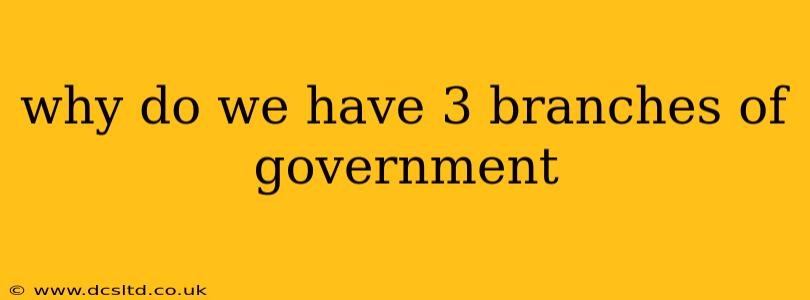Why Do We Have Three Branches of Government? A Deep Dive into Checks and Balances
The United States government's structure, with its three distinct branches – legislative, executive, and judicial – isn't arbitrary. It's a carefully crafted system designed to prevent tyranny and ensure the protection of individual liberties. The core principle underpinning this tripartite division is the concept of checks and balances. This system ensures that no single branch becomes too powerful, mirroring the concerns of the Founding Fathers who had firsthand experience with unchecked authority.
What are the three branches of government?
Let's briefly define each branch:
-
Legislative Branch (Congress): This branch is responsible for making laws. It's bicameral, consisting of the Senate and the House of Representatives. Their combined power allows for debate, compromise, and ultimately, the creation of legislation that governs the nation.
-
Executive Branch (President and Cabinet): This branch is responsible for enforcing the laws passed by Congress. The President, as head of state, leads this branch, along with various departments and agencies that carry out the day-to-day operations of government.
-
Judicial Branch (Supreme Court and Federal Courts): This branch interprets the laws and ensures they are applied fairly. The Supreme Court, at the apex of the judicial system, holds the power of judicial review, determining the constitutionality of laws passed by Congress and actions taken by the executive branch.
Why is the separation of powers important?
The separation of powers prevents the concentration of power in the hands of a single person or group, a key tenet of preventing authoritarianism. Imagine a scenario where one branch controlled all aspects of government – lawmaking, enforcement, and interpretation. The potential for abuse of power would be immense, leading to potential oppression of the citizenry.
The three branches operate independently, yet they are interconnected through the system of checks and balances. This prevents any one branch from dominating the others, fostering a balance of power and ensuring accountability.
How do the branches check and balance each other?
-
Legislative Branch Checks: Congress can impeach and remove the President or federal judges for misconduct. They also have the power to override a presidential veto with a two-thirds vote in both houses. Furthermore, Congress confirms presidential appointments to key positions, including federal judges.
-
Executive Branch Checks: The President can veto legislation passed by Congress. The President appoints federal judges, shaping the interpretation of laws.
-
Judicial Branch Checks: The Supreme Court can declare laws passed by Congress or actions taken by the President unconstitutional, thereby nullifying them.
What are the potential downsides of the three-branch system?
While the system of checks and balances is designed to prevent tyranny, it can also lead to gridlock. Disagreements between the branches can stall progress on important legislation or policy initiatives. This can lead to political polarization and inefficiency. Finding compromise and collaboration across branches is essential for effective governance.
What other governmental systems exist?
It's important to note that not all governments operate under a three-branch system. Many countries employ parliamentary systems, where the legislative and executive branches are more closely intertwined. The Prime Minister, typically the leader of the majority party in parliament, serves as head of government. While variations exist, the underlying principle of protecting citizens' rights and limiting the power of any single entity remains a common goal across diverse governmental structures.
Are there examples of checks and balances in action?
History provides numerous examples of checks and balances in action. The impeachment proceedings against Presidents Andrew Johnson and Bill Clinton, though resulting in different outcomes, illustrate the legislative branch's power to hold the executive accountable. Supreme Court rulings striking down laws demonstrate the judicial branch's role in safeguarding constitutional principles. These examples highlight the dynamism and crucial role of the system in upholding democratic values.
In conclusion, the three-branch system of government, with its intricate system of checks and balances, is a cornerstone of American democracy. While it presents challenges, its fundamental purpose – to prevent tyranny and protect individual liberties – remains paramount. Understanding this system is critical to engaging in informed civic participation and promoting a well-functioning democracy.
